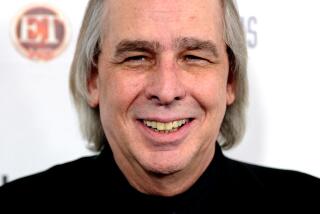Santa Barbara Station Tunes In to Shows and Movies : Radio: The owner of the tiny AM outlet wants to take his show on the road, but broadcasting analysts are skeptical.
There’s no business like show business, syndicated radio producer Ron Cutler kept telling himself. So wouldn’t it be loverly for people to have a radio station they could turn to and hear only tunes from their favorite Broadway and movie musicals?
Rather than look somewhere over the rainbow to realize his idea, Cutler turned to one of his favorite cities: Santa Barbara.
Listeners can now hear what Cutler calls “the music that America loves, but radio forgot” on KTUN-AM (990), a 5,000-watt station that Cutler purchased last July for $300,000. It is said to be the only station in the country devoted to playing show tunes and movie scores. (Two years ago, San Bernardino County’s KSHO-AM (540) flirted with a show-tune format for about six months, but dropped it in favor of jazz.)
A recent block of music on KTUN included “The Continental,” sung by Fred Astaire from the 1934 film “The Gay Divorcee”; “No Two People Have Ever Been So in Love,” sung by Danny Kaye and Jane Wyman from the 1953 movie musical “Hans Christian Andersen”; “A Wonderful Day Like Today,” sung by Cyril Ritchard from the 1965 Broadway musical “The Roar of the Greasepaint, the Smell of the Crowd”; “Georgy Girl,” sung by the Seekers from the 1966 film of the same name; “More,” sung by Andy Williams from the 1961 Italian film “Mondo Cane,” and “Nobody Does It Better,” sung by Carly Simon from the 1977 James Bond thriller “The Spy Who Loved Me.”
Implementing the format felt a little like the birth of a child for Cutler, and so he promptly christened the station “SAM.”
SAM is also an acronym for “Shows and Movies” and allows the station to proclaim in its promotional announcements, “Play it again, SAM!”
“SAM is the only station in the country, to my knowledge, that has a name,” Cutler said. “We wanted to personalize it.”
At the same time, the station was developed in such a broad, generic way as to make it easily transferable to Anytown, USA.
“Everything we’ve designed on that station is designed like a McDonald’s franchise,” Cutler said. “The whole thing is designed to be able to pick it up and move it to any market.”
Cutler’s master plan was to introduce the station in a small market--Santa Barbara has 26,100 listeners during any quarter-hour period, compared to 1,655,900 listeners in the Los Angeles area--and then take it on the road.
“What I was trying to do in Santa Barbara is sort of like (trying out a show in) New Haven before going to Broadway,” Cutler explained.
He thinks his hometown of Los Angeles would be an especially receptive market for the venture. “If SAM was in Los Angeles, I think a lot of people would gravitate to it. . . . We’ve had people calling us from Los Angeles asking us about it after they went through Santa Barbara.”
But KTUN will have to do better in its Santa Barbara tryout before he can make a serious pitch to take the format elsewhere. In its first Arbitron ratings last fall, KTUN drew an average of less than 1% of the audience, or about 200 listeners.
Still, its audience seems to be appreciative.
“I listen to it every day,” said Mitchell McCrea, a 36-year-old administrative worker and pianist, “and find it stirs up a lot for me emotionally, a lot of memories. . . . It’s good background music and also it’s just plain good music. When I listen to it I think a lot about when I was a kid, growing up.”
Betty Hart, a 76-year-old homemaker, said, “All of the tunes are ones that I treasure. I’m an old lady and I appreciate the wonderful music that we used to have that we don’t have any more.”
Radio analysts had mixed reactions to the concept.
“I think it’s a creative idea,” said San Francisco-based broadcast consultant John Lund. “I heard a little of the station a month ago when I was in Santa Barbara. I was impressed by the idea that it’s something new and different. It certainly has a much broader programming attraction than the all-Elvis or all-Beatles stations that have been tried in America.”
But the format has built-in problems, he cautioned.
“The good news is it plays music that’s not heard on the radio,” Lund said. “The bad news is, while it certainly fills a niche, it plays music targeted to people over 55, and advertisers are always looking at that prized 25-54 demographic.”
Encino-based radio consultant Allen Klein was even more downbeat about the format’s outlook.
“Every few years somebody tries that and it kind of very slowly sinks into the sunset,” Klein said. “The initial response in terms of letters and phone calls is fabulous. But it never translates into ratings.”
Aware of the obstacles, Cutler said that he has fine-tuned the station and added more music from movies and shows from the ‘60s through ‘90s in an effort to attract a broader--and younger--audience. He also altered the rotation of songs.
“It really was hard to listen to for any length of time at first,” Cutler said. “We’ve smoothed it out. Before, a lot of the songs were unfamiliar. We played songs from ‘Miss Saigon,’ songs that were great but the audience was unfamiliar with them. (And) there’s a limit to how much certain show tunes can be played to get positive results. Now, each show tune is played no more than once a month.”
Some of those melodies are used for the station’s 25 different promotional jingles.
“We’re off to hear the music, the wonderful music from SAM,” sings one jingle based on “The Wizard of Oz.” Another, from “Gypsy”: “Let us entertain you, SAM-99 AM, yessir, SAM 99-AM.”
“We get fan mail for our jingles,” Cutler said.
More to Read
The biggest entertainment stories
Get our big stories about Hollywood, film, television, music, arts, culture and more right in your inbox as soon as they publish.
You may occasionally receive promotional content from the Los Angeles Times.










